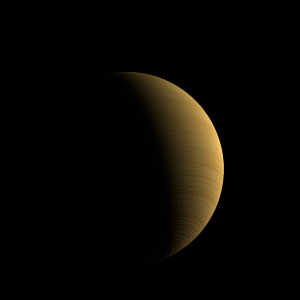| Scientific (actual) data |
|---|
| Name | KELT-9 Ab |
| Planet status | Confirmed |
| Planet mass | 2.88 |
| Radius | 1.936 |
| Orbital period | 1.48112 |
| Semi major axis | 0.03368 |
| Orbit eccentricity | 0 |
| Inclination | 86.9 |
| Discovered | 2017 |
| Updated | 2024-08-04 |
| Tzero tr | 2458680 |
| Tzero tr sec | 2457100 |
| Lambda angle | -85 |
| K | 293 |
| Temperature (kelvin) | 3921 |
| Publication | Published in a refereed paper |
| Detection type | Primary Transit |
| Mass measurement type | Radial Velocity |
| Radius measurement type | Primary Transit |
| Alternate names | HD 195689 b, HD 195689 Ab, TOI-1150 b, TOI-1150.01 |
| Molecules | Ba, Ca, Cr, Cr II, Fe, Fe+, FeH, Fe II, H, H2, K, Mg, Na, NI, O, Sc, Sc II, Sr, Tb, Ti, Ti+, TiO, V, VO, Y II |
| Star name | KELT-9 A |
| Right ascension | 307.86° |
| Declination | 39.94° |
| Mag v | 7.59 |
| Mag j | 7.46 |
| Mag h | 7.49 |
| Mag k | 7.48 |
| Star distance | 204.455 |
| Star metallicity | -0.03 |
| Star mass | 2.52 |
| Star radius | 2.362 |
| Star sp type | B9.5-A0V |
| Star age | 0.3 |
| Star temperature | 10170 |
| Star alternate names | HD 195689, TOI-1150 |
| Wikipedia article | KELT-9 Ab |
Back
| |
| Fictional info (?) |
|---|
| Suggested name | Zwenya-x |
| Planet type | Large hot gas giant |
| It is the coldest planetary atmosphere in its solar system, with a minimum temperature of 73°K (-200°C), and has a complex, layered cloud structure with Mg, thought to make up the lowest clouds, and VO, the uppermost layer of clouds.
It has the densest atmosphere of the three large hot gas giants, consisting mostly of VO,. |
| Atmosphere | VO, | 14% |
| Mg, | 12% |
| Fe+, | 12% |
| Y | 11% |
| Tb, | 11% |
| NI, | 8.7% |
| FeH, | 8.5% |
| II | 7.4% |
| V, | 4.3% |
| Sc | 3.6% |
| Sc, | 2.2% |
| Ca, | 0.68% |
| Cr, | 0.52% |
| Ti+, | 0.5% |
| Ti, | 0.37% |
| Fe | 0.3% |
| TiO, | 0.21% |
| H2, | 0.2% |
| Sr, | 0.18% |
| Na, | 0.02% |
| Ba, | 0.014% |
| O, | 0.014% |
| II, | 0.00032% |
| Fe, | 1.5E-5% |
| K, | 1.4E-5% |
| H, | 2.0E-6% |
| Cr | 0% |
| Atmospheric pressure | 1.2 bar |
 |
| No known satellites |
| Google search for Zwenya-x |
|